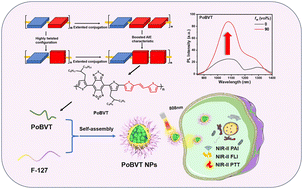Conjugated polymers (CPs), which emit in the second near-infrared window (NIR-II, 1000–1700 nm), are used as biomaterials for NIR-II fluorescence imaging because of their adjustable photophysical properties and high optical stability. However, the fluorescence signal of conventional CPs is quenched in an aggregated state due to strong π–π stacking, which results in the closure of the radiation attenuation pathway. To solve this problem, the aggregation-induced emission effect is considered a reasonable strategy for enhancing the aggregative fluorescence of IR-II emitters. We herein report NIR-II conjugated polymers with typical AIE characteristics (αAIE > 3) by changing the side chain structure of receptor units and the conjugation degree of donors. Conjugated polymer nanoparticles (PoBVT NPs) exhibit outstanding performance in NIR-II fluorescence imaging (QY = 1.94%) and highly effective photothermal therapy (η = 45%). In vivo studies have shown that the location of tumors can be accurately obtained by NIR-II FL/NIR-II PA imaging, and there is a significant anti-tumor effect after laser irradiation. This work offers prospects for the design of multifunctional conjugated polymers for NIR-II FL/PA imaging to guide NIR-II PTT applications.
